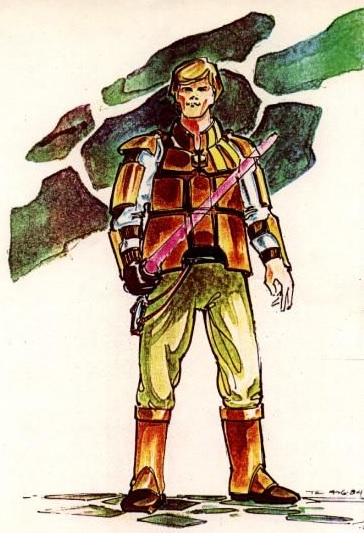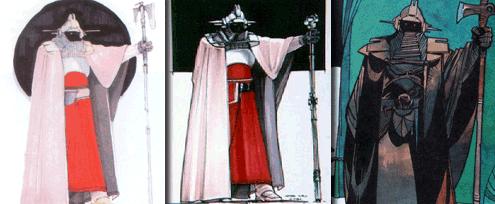Atha Prime, an egotistical genetics master and ruler of the "dark worlds," was one of the architects of the Clone Wars, a pan-galactic conflict that raged from 22 BBY to 19 BBY and ended with the collapse of the Galactic Republic and the subsequent rise of the Galactic Empire. During those wars, Prime attacked the mountainous world of Skye, committing terrorist acts that were genetic in nature. He was defeated there by General Obi-Wan Kenobi, along with Commanders Anakin Skywalker and Halagad Ventor. For a short while, he was involved with Grand Moff Trachta, who would later move against Palpatine in an attempted Anti-Sith coup.

Prime's adversary, Luke Skywalker.
Prime was exiled from the Empire and forced to reside in a remote fringe of the galaxy. The first death of Emperor Palpatine in 4 ABY at the Battle of Endor freed Prime from his exile and allowed him to begin his intended bloody conquest of the galaxy. He had been able to harness the power of cloning technology, and with it, he created an army of Clone Warriors that were his to command.
With the Empire in disarray, Prime, along with his armies, began his campaign by securing control over the fragments of the Imperial forces. He then began to enslave worlds that had recently been liberated by the Alliance to Restore the Republic and conquered worlds held by his foes along the galactic frontier. It was his intent to completely wipe out the Alliance and take control of the entire galaxy. As a result, Prime and his armies were forced to battle the Alliance, specifically the Jedi Knight Luke Skywalker and war hero Han Solo. Meanwhile, Grand Moff Wilhuff Tarkin, who had narrowly escaped death at the Battle of Yavin in 0 ABY, emerged from hiding to take control of the shattered remains of the Galactic Empire.
For transport during his campaign, Prime used his personal ship, the starfighter Apex Invader, which was piloted by the droid Blue-Four. Blue-Four also served as Prime's personal attendant. Prime's flagship for the campaign was the double-decker Star Destroyer Annihilator, the bridge complex of which the Apex Invader could connect to. While connected, Prime would have the ultimate vantage point in a battle, and he would be able to command both ships simultaneously. The Annihilator was roughly the size of a city, and apart from being the flagship of Prime's navy, it served as a mobile command base.
An egotistical man, Atha Prime was also patient, biding his time in exile until the galaxy would be vulnerable. As a leader, he was able to rally the remainder of the Imperial forces in the wake of the Battle of Endor, and put them to effective use, enslaving worlds that had only recently experienced freedom from Palpatine's rule.

Concept art for a royal guard shown next to Atha Prime and an Imperial Sentinel
In 1984, a year after the release of Star Wars: Episode VI Return of the Jedi and the third Star Wars toy line, Kenner decided to create a new line, dubbed "Power of the Force," in an attempt to renew interest in the brand. At first, most of the figures in the line were ones from Return of the Jedi that had not been produced in 1983–84, but eventually the company began to develop small vehicles that were of original design and had not appeared in the films. The original vehicles were a success, prompting Kenner to take their idea further by creating a set of characters that would populate a new storyline taking place after Return of the Jedi, and that would be released in 1986.
Hoping to push the Star Wars saga in a new direction, the Kenner designers created Atha Prime, who would serve as the main villain in the new plot line, which involved him battling redesigned versions of Luke Skywalker and Han Solo. In addition to Prime, they also designed the Clone Warriors, which would serve as Prime's soldiers and replacements to the stormtroopers featured heavily in the films. Prime was given two vehicles, which would be made into playsets, and a droid attendant. In particular, Prime would be used in conjunction with the Apex Invader toy. He was also identified as an architect of the Clone Wars, although in 2002, when Star Wars: Episode II Attack of the Clones was released, it was shown that Palpatine and Dooku were the true masterminds of that conflict.
For visual representation of Prime, the Kenner designers made scant adjustments to a piece of concept art from Return of the Jedi pre-production. The art, done in 1981 by Nilo Rodis-Jamero, was originally meant to be a design for the Emperor's Royal Guard, although the final version of that design differed significantly from Rodis-Jamero's work. In reusing that design, Kenner's adjustments included changing the guard's axe-like weapon into a staff and slight alterations to the figure's headpiece.

Shadowspawn, the character Abel G. Peña attempted to consolidate with Atha Prime
Kenner's ideas were eventually rejected by Lucasfilm Ltd., who were apparently not ready to undertake a concerted effort to create an Expanded Universe set after Return of the Jedi. In 1986 the last issue of Marvel Comics' Star Wars comic run, Star Wars (1977) 107 would be published, which would turn out to be the start of a hiatus on post-Return of the Jedi content, until 1991 when Timothy Zahn's Heir to the Empire was released by Bantam Spectra. That year, Tom Veitch's Star Wars: Dark Empire comic mini-series would introduce the Imperial Sentinels, which bore great resemblance to Prime. They were in fact based on the same Return of the Jedi concept art that Prime had been modeled on.
The character of Prime was all but forgotten, until Official Star Wars Fact File author Abel G. Peña wrote him into the backstory of the coup attempt featured in Star Wars: Empire: Betrayal. The reference, however, which was to go in the article published in issue 122 of the Fact File, was cut from the released product. Peña was not deterred and made another, more elaborate connection in an article on Imperial Warlords that he wrote with Daniel Wallace. This time, Peña consolidated the character of Prime and the established character of Shadowspawn from the Dark Empire Sourcebook, making them one and the same. But the subsequent cancellation of Polyhedron magazine, which the article had been written for, left it unpublished and the connection non-canon. For three years, Peña attempted to resell the article, to no avail. He was eventually able to canonize at least an element of Prime's character with the 2007 Aliens in the Empire article, co-written by Rich Handley. In it, there is a reference to a "genetics terrorist" that Peña intended to be Prime.
A blurb of the novel Luke Skywalker and the Shadows of Mindor, by Matthew Stover, published by StarWars.com on May 22, 2008, contained information pertaining to Shadowspawn that matched specific elements of Kenner's brief for Atha Prime, particularly the phrase, "The Emperor's death has paved the way for Shadowspawn's return from exile in the Outer Rim…" This led to speculation on the Jedi Council Forums as to whether or not Stover had retained Peña's unpublished backstory of Shadowspawn that consolidated him with Prime although Peña stated to not expect that as only he and Daniel Wallace had seen his Shadowspawn backstory. Upon its release, however, the book was revealed to have no mention of Prime whatsoever.
In March of 2015, the "unnamed genetics terrorist" was detailed in SkyeWalkers: A Clone Wars Story, a novella written by Abel G. Peña, and given the name "Zeta Magnus."
- Star Wars: The Action Figure Archive
- The Official Star Wars Fact File122
- "Galactic Bazaar: Tales of Phantom Toys" — Star Wars Galaxy Magazine 2
- Aliens in the Empire
- "Prequels in Plastic and Other Toy Tales" — Star Wars Insider 121